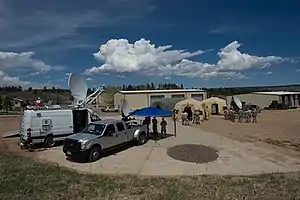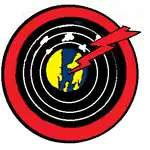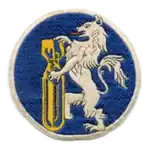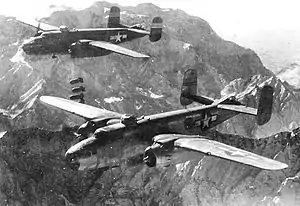379th Bombardment Squadron
The 379th Space Range Squadron is an Air Force Reserve unit. It is assigned to the 926th Wing, and is located at Schriever Air Force Base, Colorado.
| 379th Space Range Squadron | |
|---|---|
 379th Space Range Squadron field training at Schriever AFB | |
| Active | 1942–1945; 1947–1949; 1952–1965; 2012–present |
| Country | |
| Branch | |
| Role | Range management |
| Part of | Air Force Reserve Command |
| Garrison/HQ | Schriever Air Force Base |
| Decorations | Distinguished Unit Citation Air Force Outstanding Unit Award |
| Insignia | |
| 379th Space Range Squadron emblem[1] (restored) |  |
| 379th Bombardment Squadron emblem (approved 21 January 1958)[2] |  |
| Patch with 379th Bombardment Squadron emblem[3] |  |
| World War II tail markings[3] | Yellow horizontal stripe (310th Group) with narrower white horizontal stripe below (for 379th Squadron) |
For most of its existence the unit was designated the 379th Bombardment Squadron, and was most recently stationed under that name at Shilling Air Force Base, Kansas, where it was inactivated on 25 March 1965.
History
World War II

Activated in mid-1942 at Davis–Monthan Field, Arizona as a North American B-25 Mitchell medium bomber squadron, but moved on paper the same day to Jackson Army Air Base, Mississippi. The squadron trained under Third Air Force in the southeastern United States. It was deployed initially to England in September 1942 and flew some missions under VIII Bomber Command over German-occupied France; attacking enemy troop formations, bridges and airfields. It was part of Operation Torch, the invasion of North Africa in November 1942, being deployed to the new Mediterranean Theater of Operations. The squadron was assigned to the Twelfth Air Force in French Morocco in November, when it was engaged primarily in support and interdictory operations, bombing marshalling yards, rail lines, highways, bridges, viaducts, troop concentrations, gun emplacements, shipping, harbors and other objectives in North Africa.
The squadron also engaged in psychological warfare missions, dropping propaganda leaflets behind enemy lines. It took part in the Allied operations against Axis forces in North Africa during March–May 1943, the reduction of Pantelleria and Lampedusa islands during June and the invasion of Sicily in July. It was also involved in the landing on the Italian mainland at Salerno in September, the Allied advance toward Rome during January–June 1944, Operation Dragoon, the invasion of Southern France in August 1944 and Allied operations in northern Italy from September 1944 to April 1945. It was inactivated in Italy after the German capitulation in September 1945.
Air Force Reserve
It was reactivated as part of the Air Force Reserve in 1947, although it is unclear whether or not the squadron was manned or equipped. It was inactivated in 1949.
Strategic Air Command
Reactivated in 1952 as a Strategic Air Command squadron, the unit received Boeing B-29 Superfortress bombardment training from the 90th Bombardment Wing between April and August 1952. It acted as a training squadron until 1954 when it replaced the propeller-driven B-29s with new Boeing B-47E Stratojet swept-wing medium bombers. These aircraft were capable of flying at high subsonic speeds and were primarily designed for penetrating the airspace of the Soviet Union. By the early 1960s, the B-47s were considered to be reaching obsolescence, and were being phased out of SAC's strategic arsenal. They were sent to AMARC at Davis–Monthan Air Force Base in early 1965. The squadron was inactivated in March.
Space range unit
The squadron was redesignated the 379th Space Range Squadron and activated at Schriever Air Force Base, Colorado on 1 April 2012.[4] It serves as a reserve associate unit with the regular Air Force 25th Space Range Squadron.[5] In 2014, the squadron's gaining command changed from Air Force Space Command to Air Combat Command. The squadron has participated in exercises Austere Challenge, Anakonda and Juniper Cobra in Europe; Global Thunder, Global Lightning, Ardent Sentry and Red Flag in the United States; and Valiant Shield in the Pacific.[6]
Lineage
- Constituted as the 379th Bombardment Squadron (Medium) on 28 January 1942
- Activated on 15 March 1942
- Redesignated 379th Bombardment Squadron, Medium c. 20 August 1943
- Inactivated on 12 September 1945
- Redesignated 379th Bombardment Squadron, Light on 11 March 1947
- Activated in the reserve on 9 August 1947
- Inactivated on 27 June 1949
- Redesignated 379th Bombardment Squadron, Medium on 15 March 1952
- Activated on 28 March 1952[7] (not operational until 4 March 1952)[8]
- Discontinued and inactivated on 25 March 1965[4] (not operational after 25 February 1965)[8]
- Redesignated 379th Space Range Squadron on 14 February 2012[4]
- Activated on 1 April 2012[4]
Assignments
- 310th Bombardment Group, 15 March 1942 – 12 September 1945
- 310th Bombardment Group, 9 August 1947 – 27 June 1949
- 310th Bombardment Wing (later 310th Strategic Aerospace Wing), 28 March 1952 – 25 March 1965[7][8]
- 310th Operations Group, 1 April 2012[4]
- 926th Operations Group, 2014[6]
Stations
|
|
Aircraft
- North American B-25 Mitchell, 1942–1945
- Boeing B-29 Superfortress, 1952–1954
- Boeing B-47 Stratojet, 1954–1965[7]
See also
References
Notes
- No byline (10 March 2016). "379th SRS NCO named Outstanding Airman of the year". 926th Wing Public Affairs. Retrieved 13 April 2018.
- Maurer, Combat Squadrons, pp. 468–469
- Watkins, pp. 80–81
- Research Division, Air Force Historical Research Agency, Air Force Organization Change Status Report, April 2012, Maxwell AFB, AL
- Ontiveros, TSG Nicholas (3 March 2013). "379th is now official". 310th Space Wing Public Affairs. Retrieved 12 April 2018.
- D'Ambrosio, Maj Jessica (13 July 2016). "379th SRS welcomes new commander". 926th Wing Public Affairs. Retrieved 12 April 2018.
- Lineage, including assignments, aircraft and stations through 1963 in Maurer, Combat Squadrons, pp. 468–469
- Ravenstein, pp. 158–159
- Mueller, p.221
- Bibliography
![]() This article incorporates public domain material from the Air Force Historical Research Agency.
This article incorporates public domain material from the Air Force Historical Research Agency.
- Maurer, Maurer, ed. (1983) [1961]. Air Force Combat Units of World War II (PDF) (reprint ed.). Washington, DC: Office of Air Force History. ISBN 0-912799-02-1. LCCN 61060979.
- Maurer, Maurer, ed. (1982) [1969]. Combat Squadrons of the Air Force, World War II (PDF) (reprint ed.). Washington, DC: Office of Air Force History. ISBN 0-405-12194-6. LCCN 70605402. OCLC 72556.
- Mueller, Robert (1989). Air Force Bases, Vol. I, Active Air Force Bases Within the United States of America on 17 September 1982 (PDF). Washington, DC: Office of Air Force History. ISBN 0-912799-53-6.
- Ravenstein, Charles A. (1984). Air Force Combat Wings, Lineage & Honors Histories 1947–1977. Washington, DC: Office of Air Force History. ISBN 0-912799-12-9.
- Watkins, Robert A. (2009). Insignia and Aircraft Markings of the U.S. Army Air Force in World War II. Vol. IV, European-African-Middle Eastern Theater of Operations. Atglen,PA: Shiffer Publishing, Ltd. ISBN 978-0-7643-3401-6.


.svg.png.webp)